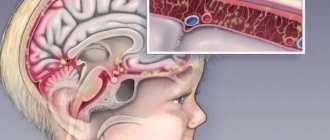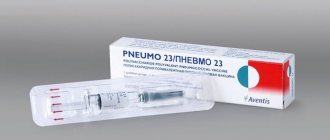"BiVac Polio" - vaccination against polio
Polio vaccine, oral, bivalent, live attenuated
Manufacturer: FSUE “PIPVE im. M.P. Chumakov RAMS, Russia.
Protects against the disease: polio.
Used: only for revaccination of children aged 6 months and older.
Included in the Russian national vaccination calendar.
Indications for vaccination "BiVac Polio"
"BiVac Polio" is indicated for revaccination (second stage of immunization) of children against polio after the first two vaccinations with inactivated polio vaccine.
Epidemic and social indications for BiVac Polio vaccination:
- Children over 3 months of age who have been in contact with a patient - a single dose.
- Doctors, paramedical and junior medical personnel who work in conditions of high risk of infection - once.
- Workers in clinical and virology laboratories who are in contact with a live wild strain pathogen receive a single vaccination during employment.
- Children over 3 years of age and adults who travel to countries with an unfavorable polio situation - once.
- For persons without a fixed place of residence - once if they have previous vaccinations, three times if they have not.
Description of the BiVac vaccine and its composition
Poliomyelitis is a dangerous disease caused by enteroviruses of serotypes 1, 2, 3. The main risk group is children under 5 years of age. The polio virus attacks the gray matter of the spinal cord, causing paralysis or death within hours. For a long time now, all countries of the world have been striving to destroy it completely, but possessing extreme vitality, it still occurs periodically. Is extremely contagious. Once in the intestines with food or water, it begins to actively multiply.
The country of origin of the drug BiVac is Russia. The vaccine includes 2 types of live attenuated Sabin strain polio viruses, types 1 and 3.
Contraindications
Only a doctor can decide whether BiVac Polio is suitable for vaccination
BiVac Polio is contraindicated if you have a history of an allergic reaction to any component of the vaccine.
BiVac Polio vaccination is contraindicated in the following cases:
- Neurological disorders accompanying previous vaccination with oral polio vaccine.
- Immunodeficiency state, malignant neoplasms, immunosuppression (vaccinations are carried out no earlier than 3 months after the end of the course of therapy).
- Pregnancy.
- Hypersensitivity to any component of the vaccine.
- Severe reaction (temperature above 40 °C) or complication to a previous drug administration.
- Acute infectious or non-infectious diseases, exacerbation of chronic diseases - vaccinations are carried out 2-4 weeks after recovery or remission. For mild ARVI and acute intestinal diseases, vaccinations are carried out after the temperature has normalized.
BiVac polio (poliomyelitis vaccine) oral solution 2 ml bottle N 10
International nonproprietary name
Vaccine to prevent polio
Dosage form
oral solution
Compound
1 dose (0.2 ml - 4 drops) contains:
Active component: polio virus, attenuated Sabin strains type 1 not less than 106.0 TCD50, type 3 not less than 105.5 TCD50 infectious units (IU) of the virus, expressed in tissue cytopathogenic doses (TCD50);
Excipients: magnesium chloride 0.018 g; kanamycin 30 mcg.
Description
Transparent liquid from yellowish-red to pink-raspberry color, without sediment, without visible foreign inclusions.
Pharmacotherapeutic group
MIBP - vaccine
ATX code
J07BF
Pharmacodynamics:
Immunological properties
The vaccine is a preparation from attenuated Sabin strains of polio virus 1 3 types grown on a primary culture of African green monkey kidney cells or on a primary culture of African green monkey kidney cells with one passage on a continuous cell culture of the Vero line and contains two types of virus (bivalent vaccine) in in the form of a solution with 05% lactalbumin hydrolyzate in Earle's solution. The vaccine creates lasting immunity to polio virus 13 types in (90-95)% of vaccinated people.
Indications:
Active prevention of polio.
Contraindications:
— Neurological disorders accompanying previous vaccination with oral polio vaccine;
— immunodeficiency state (primary) malignant neoplasms immunosuppression (vaccinations are carried out no earlier than 3 months after the end of the course of therapy);
- pregnancy;
- hypersensitivity to any component of the vaccine;
- severe reaction (temperature above 40 ° C) or complication to the previous administration of the drug;
- acute infectious or non-infectious diseases, exacerbation of chronic diseases - vaccinations are carried out 2-4 weeks after recovery or remission. For mild ARVI and acute intestinal diseases, vaccinations are carried out after the temperature has normalized.
Pregnancy and lactation:
Use during pregnancy is contraindicated.
The possibility and specifics of the medical use of the vaccine in women during breastfeeding have not been studied.
Directions for use and dosage:
Attention! The vaccine is for oral use only.
The vaccine is used 4 drops per dose. The vaccination dose of the vaccine is instilled into the mouth with a dropper or pipette attached to the bottle 1 hour before meals. It is not allowed to take the vaccine with water or any other liquid, or to eat or drink within an hour after vaccination.
In accordance with the current edition of the National Preventive Vaccination Calendar, the first and second vaccinations against polio are given to children with the inactivated polio vaccine (IPV) in accordance with the instructions for the use of IPV.
The third vaccination and subsequent revaccinations against polio are given to children with the live oral polio prevention vaccine (LOP).
The first three vaccinations make up the vaccination course.
| Vaccinations | ||||||
| Vaccination | Revaccination | |||||
| IPV | PPV | PPV | ||||
| 1 | 2 | 3* | 4* | 5* | 6* | |
| Child's age | 3 months | 45 months | 6 months | 18 months | 20 months | 14 years |
* children born from mothers with HIV infection, children with HIV infection, children staying in orphanages - the third vaccination and subsequent revaccinations against polio are carried out with IPV - a vaccine for the prevention of polio (inactivated).
For older children who have not received vaccination against polio within the prescribed period, routine immunization is carried out according to the same scheme (first and second vaccination - IPV, third vaccination and subsequent revaccinations - PPV).
In accordance with the current edition of the calendar of preventive vaccinations for epidemic indications, vaccination against polio for epidemic indications is carried out with an oral polio vaccine. When registering a case of poliomyelitis caused by wild poliovirus, isolation of wild poliovirus in human biosamples or from environmental objects, mandatory vaccination is carried out for the following categories of citizens (contact persons in foci of poliomyelitis, including those caused by wild poliovirus (or if the disease is suspected):
- children from 3 months to 18 years - once;
- medical workers - once;
- children arriving from polio-endemic (polio-affected) countries (regions) from 3 months to 15 years - once (if there is reliable data on previous vaccinations) or three times (if they are absent);
- persons without a fixed place of residence (if identified) from 3 months to 15 years - once (if there is reliable data on previous vaccinations) or three times (if they are absent);
- persons in contact with arrivals from polio-endemic (polio-affected) countries (regions) from 3 months of life without age limit - once;
— persons working with live poliovirus with materials infected (potentially infected) with wild polio virus without age limit, once upon hiring.
Features of the drug's action at the first dose
No specific effects of the drug were observed during the first dose.
Actions of the doctor and patient when one or more doses are missed
Lengthening the intervals between vaccinations is allowed in exceptional cases in the presence of medical contraindications; shortening the intervals between the first three vaccinations is not allowed.
It is allowed to reduce the interval between the third and fourth vaccinations to 3 months if the intervals between the first three vaccinations have been extended.
Side effects:
The following criteria were used to assess the incidence of adverse events: uncommon (≥ 1/1000 to <1/100) rare (≥ 1/10,000 to < 1/1000) very rare (< 1/10,000).
Reactions (except immediate allergic reactions in the first few hours after vaccination) usually cannot appear earlier than the 4th day and more than 30 days after administration of the vaccine.
Rarely - nonspecific symptoms: fever, vomiting, headache, not necessarily associated with taking the oral polio vaccine.
Very rarely - some vaccinated people may experience allergic reactions in the form of urticaria or Quincke's edema.
Isolated cases - both in vaccinated people and in people in contact with vaccinated people - have resulted in the occurrence of vaccine-associated paralytic poliomyelitis (VAPP). To prevent VAPP, the first two vaccinations against polio are carried out with the IPV vaccine.
Overdose:
An overdose does not lead to undesirable consequences.
Interaction:
Vaccinations against polio are allowed to be carried out on the same day with vaccination with DTP vaccine (ADS or ADS-M toxoid); simultaneous administration of polio vaccine with other drugs of the National Preventive Vaccination Calendar is allowed.
Immunosuppressants may reduce the immune response to oral polio vaccine by allowing vaccine viruses to multiply and prolonging the shedding of vaccine viruses in feces.
Special instructions:
All persons who are to receive preventive vaccinations must be examined by a doctor (paramedic).
In children's organized groups, it is necessary to plan vaccinations against polio for all children in the group at the same time.
Children who have not been vaccinated against polio should be separated from those recently vaccinated with PPV for a period of at least 60 calendar days from the date of vaccination.
To limit the circulation of the vaccine virus among those around the vaccinated child, the rules of personal hygiene of the child after vaccination should be observed (separate bed, potty, separate bedding, clothing from other children and the need to isolate the vaccinated child in the family from immunodeficiency patients).
In families where there are unvaccinated children due to age (newborns) or who have contraindications to polio vaccinations, the IPV vaccine should be used to immunize children belonging to the target groups.
All vaccinations against poliomyelitis are registered in established registration forms indicating the name of the drug, date of vaccination, dose, series number of reaction to the vaccine.
Unused vaccine from an opened vial can be stored for no more than 2 days at a temperature of 2 to 8 ° C in a vial tightly closed with a dropper or rubber stopper. The drug in a bottle with a damaged labeling, as well as with a change in its physical properties (transparency color, etc.), if the expiration date has expired, if the conditions of transportation and storage have been violated, is not suitable for use.
Precautions for use
The vaccine should not be administered parenterally!
If vomiting or diarrhea occurs during or immediately after administration of the vaccine, a second dose of the vaccine may be administered after these symptoms have resolved.
In the case of an upcoming planned operation, vaccinations should be carried out no later than 1 month before the operation. During emergency surgery, immunization should not be carried out earlier than 3-4 weeks after surgery.
Due to the potential risk of apnea in preterm infants (less than 28 weeks) and in children with a history of respiratory distress, continuous monitoring of respiratory activity is necessary due to the possibility of apnea occurring within 48-72 hours.
Impact on the ability to drive vehicles. Wed and fur.:
Does not affect the ability to drive vehicles and perform work requiring increased concentration and speed of psychomotor reactions.
Release form/dosage:
Oral solution 02 ml/dose.
Package:
20 ml (10 doses) in a bottle.
10 bottles along with instructions for use are placed in a cardboard pack.
Storage conditions:
In accordance with SP 3.3.2.2329-08 (amendments and additions to SP 3.3.2.1248-03), the vaccine is stored: at level 1 of the “cold chain” - at a temperature of minus 20 ° C and below when transporting the vaccine at a temperature range from 2 to 8 °C, subsequent re-freezing to minus 20 °C is allowed (at level 2 of the “cold chain”). At the 3rd and 4th levels of the “cold chain” the vaccine is stored at a temperature of 2 to 8 °C.
Keep out of the reach of children.
Transportation conditions
In accordance with SP 3.3.2.2329-08 at temperatures from 2 to 8 °C.
Best before date:
2 years at temperatures minus 20 °C and below
6 months at temperatures from 2 to 8 °C.
Vacation conditions
On prescription
Possible side effects
In rare cases, in the first few hours after taking BiVac Polio, an immediate allergic reaction may develop. After administration of the vaccine, usually from 5 to 13 days, the following reactions may appear: vomiting, fever, headache. Allergic reactions (Quincke's edema, urticaria) occur very rarely. It is extremely rare, in absolutely isolated cases, that vaccine-associated paralytic poliomyelitis occurs.
Come get vaccinated at VIRILIS. A full range of vaccines for children and adults, family vaccinations - at a special price!
Application of the BiVac vaccine
The vaccine is taken orally (4 drops in the mouth). The course of primary immunization against polio is 3 procedures, after which revaccination is required. After a full course, resistance to polio viruses persists for 5 years or more. Can be used in combination with vaccines against diphtheria, whooping cough, tetanus, hepatitis B, etc. But it should be borne in mind that this immunobiological drug is suitable for use in children starting from the 3rd vaccination. The first two are carried out with inactivated (killed) viruses.
special instructions
Before vaccination, the patient must be examined by a pediatrician or therapist.
In child care facilities, it is necessary to schedule polio vaccinations for all children in the group at the same time.
Contact of unvaccinated children with vaccinated PPV should not be allowed within 60 calendar days from the date of vaccination.
To limit the circulation of the vaccine virus, strict adherence to personal hygiene rules is required after vaccination. First of all, it is necessary to isolate family members with immunodeficiency from the vaccinated child. The child should be provided with a separate bed, potty, bedding and clothing.
To immunize a child belonging to the target groups, in whose family there are children who have not yet been vaccinated (due to age or with contraindications to vaccination against polio), IPV should be used.
Vaccinations against polio must be registered on established registration forms, which indicate the name of the drug, date of vaccination, dose, batch number, reaction to the vaccine.
After opening, the vaccine in a tightly closed vial is suitable for use for no more than 48 hours at a storage temperature of 2–8 °C.
Do not use the drug from a bottle with damaged integrity and labeling, or if there are visible changes in its physical properties.
If the patient experiences vomiting or diarrhea during or immediately after taking the vaccine, a second dose of the vaccine can be taken after the condition has returned to normal.
Accidentally exceeding the dose does not cause undesirable consequences.
Vaccination cannot be carried out later than 4 weeks before a planned operation and earlier than 3-4 weeks after surgery for emergency indications.
With a history of respiratory failure and in premature infants (less than 28 weeks) while taking BiVac polio, there is a high risk of apnea. Therefore, this category of children must be constantly monitored for respiratory activity during the first 48–72 hours after vaccination.
To reduce the risk of developing VAPP, the first 2 vaccinations are given with the IPV vaccine.
After an exacerbation of chronic pathologies or acute non-infectious and infectious diseases, the vaccine can be taken only 2-4 weeks after remission or complete recovery.
For mild forms of acute respiratory viral infections and acute intestinal diseases, vaccination is carried out after the temperature has normalized.
In case of immunosuppression, vaccination can be carried out only 12 weeks after the end of treatment.
Directions for use and dosage
The vaccine is intended for oral use only!
The vaccination dose is 4 drops (0.2 ml), they are instilled into the patient’s mouth using a pipette or a dropper attached to the bottle. You are not allowed to drink or eat for one hour after the procedure.
The first and second vaccination against polio for children is carried out with inactivated polio vaccine (IPV) for prevention, according to the relevant instructions for the use of IPV.
The third vaccination and subsequent revaccinations against polio are given to children with live oral polio vaccine (LOV).
The vaccination course consists of the first three vaccinations:
- first: at the age of 3 months of life – IPV;
- second: at 4.5 months – IPV;
- third: at 6 months – PPV.
Revaccination against polio is carried out in accordance with the preventive vaccination calendar in 3 stages: at the ages of 18 and 20 months, then at 14 years.
Exceptions to the general rules of vaccination and revaccination are children in orphanages, children with HIV infection or those born to HIV-infected mothers. The third vaccination and subsequent revaccinations against polio for this category of children must be carried out with IPV.
If routine immunization of a child begins over the age of three months, it is also carried out according to the established scheme.
If a case of polio caused by wild poliovirus isolated in human biosamples or from environmental objects is registered, mandatory vaccination is required. Categories of citizens who are contact persons in an outbreak of polio (or suspected disease), including those caused by wild poliovirus, are subject to an additional single vaccination. These include:
- children from 3 months to 18 years;
- medical workers;
- children from 3 months to 15 years old who arrived from polio-affected countries or regions (in the absence of reliable data on previous vaccinations, three-time vaccination is indicated);
- children from 3 months to 15 years of age without a fixed place of residence (in the absence of reliable data on previous vaccinations, three-time vaccination is indicated);
- persons 3 months of age and older who are in contact with people arriving from polio-affected countries or regions;
- persons of no age limit who work with materials potentially infected with wild poliovirus or live poliovirus - upon hiring.
The intervals between the first three vaccinations should not be reduced.
In the presence of medical contraindications, in exceptional cases, lengthening the intervals between vaccinations is allowed. If the interval between the first three vaccinations is prolonged, the date of the fourth vaccination can be postponed 3 months earlier.
Drug interactions
On the same day with the use of BiVac polio, vaccination with adsorbed pertussis-diphtheria-tetanus vaccine (DTP vaccine) or adsorbed diphtheria-tetanus vaccine (ADS and ADS-M anatoxin) is allowed. In addition, the administration of the polio vaccine is allowed simultaneously with other drugs in the National Preventive Vaccination Calendar.
Immunosuppressive drugs may reduce the immune response to polio vaccine, promote the multiplication of vaccine viruses, and prolong the time it takes for vaccine viruses to be excreted in stool.
Release form and composition
Dosage form – solution for oral administration: a transparent liquid from pink-raspberry to yellowish-red color, without sediment and visible foreign inclusions [2 ml (10 doses) in a bottle, 10 bottles in a cardboard box].
1 dose contains:
- active ingredient: polio virus, attenuated Sabin strains type 1 - at least 10 to 6 degrees TCD50 (tissue cytopathogenic doses) and type 3 - at least 10 to 5.5 degrees TCD50 infectious units (IU) of the virus;
- auxiliary components: kanamycin, magnesium chloride.
Preparing a child for vaccination
To prevent vaccination from adding any hassle to you and your baby, you need to follow simple recommendations:
- Take blood and urine tests. Elevated or decreased ESR values are temporary contraindications. It is also not advisable to inject in case of acute anemia.
- After a severe illness, it is advisable to postpone vaccination for at least 2 weeks.
- Visit the offices of a neurologist and pediatrician.
- Do not feed or water your child for 30-40 minutes after vaccination
- Avoid hypothermia and overheating.
- Make sure you have paracetamol and ibuprofen in the house. Fever is a natural reaction to vaccination.
All the vaccines we use comply with WHO standards, which guarantees their effectiveness, safety and reduced risk of side effects.







